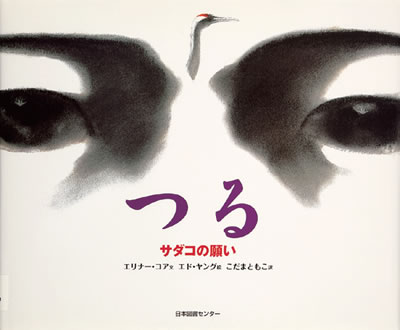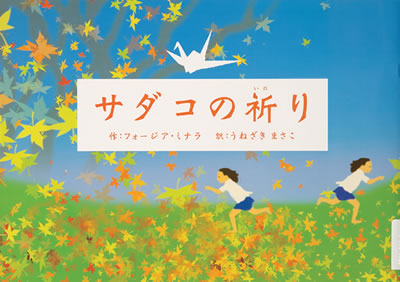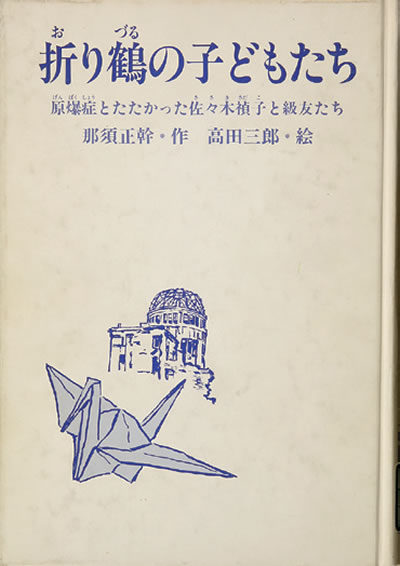Part 3 : Special Corners
Sadako: A story from real life has been introduced to overseas countries in the form of children's books.
The Beginning of the Sadako Story
In the Hiroshima Peace Memorial Park, there is a Statute of the A-Bomb Children. The statue is modeled on the young girl Sadako Sasaki (1943 – 1955). When she was two years old, Sadako was exposed to the radiation of the atomic bomb. She developed leukemia 10 years later and died at the age of 12. Before dying, she folded paper cranes, praying for recovery from her illness. Her story was conveyed in the form of children's books and is well known in Japan. In one overseas country, an author inspired by media reporting about Hiroshima published Sadako's story in the form of a children's book, which was translated in many countries in response to the growing antinuclear and peace movement, becoming widely known throughout the world.
The Sadako Story was introduced to overseas countries not through the translation and publication of a book written by a Japanese author, but through the publication of the books about Sadako and the paper cranes she folded written by foreign authors inspired by the true story of Sadako Sasaki. These works were also translated into Japanese for publication in Japan. The books that served to spread Sadako's story across the globe are:
“Sadako will leben!”(No.253)(Its Japanese editions: “Sadako wa ikiru”No.255、and “Sadako” No.256)
“Sadako and the thousand paper cranes”(No.257)(Not translated into Japanese)
Imaginatively, these two works depict Sadako folding paper cranes in the belief that if she folds thousand paper cranes, her wish will come true.







“Sadako will leben!”(Sadako wa ikiru No.253)
Austrian writer Karl Bruckner (1906 – 1982) won the City of Vienna Children's Book Prize and the Austrian Children's Book Prize for “Sadako will leben!” In 1962, 1964, and 1966, he was nominated for the Hans Christian Andersen Award. As soon as this work was released, it became a bestseller in Austria and Germany, and it was later translated in Europe, the United States (No.254) and the rest of the world. In 1963, the book was translated into Japanese and later temporarily went out of print. In 2000, however, a revised version of the book was republished. (No.256)
“Sadako and the thousand paper cranes”(Sadako to senbazuru No.257)
Eleanor Coerr (1922 - 2010), a Canadian-born American writer of children's books, came to Japan as a journalist for the Ottawa Journal in 1949 and visited Hiroshima in 1950. When she visited Hiroshima again in the 1960s, she learned of Sadako's story. Later, she wrote this book based on the collection of compositions compiled in memory of Sadako by Sadako's classmate, and she published it in 1977, for which she received the West Australian Book Award and the OMAR Award. Among the many books on Sadako, it is said that this is the most read book in the world. It was translated in many countries, including Sweden (No.258), France (No.259), China, Spain and Russia.
The Spread of the Sadako Story
The Sadako Story, which was made famous worldwide by the books written by Karl Bruckner and Eleanor Coerr, has been spreading around the world. In the 1990s, the English translation of the nonfiction novel “Orizuru no kodomo tachi: genbakusho to tatakatta Sasaki Sadako to kyuyu tachi” (No.265) written by Masamoto Nasu was published in the United States (No.266). It is said that the picture book “Sadako”(No.260), which was written by Eleanor Coerr and illustrated by Caldecott Medal-winning artist Ed Young, has helped the further spread of Sadako's story. This picture book published in the United States was translated in Japan (No.261), Germany (No.262), the Netherlands, Sweden and other countries. In the 2000s, a picture book about Sadako (No.263) was published in India, and a picture book about her story published in Pakistan was translated in Japan (No.264).
Moreover, the Sadako story has been introduced to children as part of their classes. In Mongolia, her story has become a song, and in the United States, a statute of Sadako has been erected in a park. Thus, Sadako's story has been conveyed around the globe in various forms.


Y18-N05-H241





For copyright reasons, images of some books are not available in this electronic exhibition.
- TOP
- Part 3 Special Corners
- Sadako: A story from real life has been introducted to overseas countries in the form of children's books

